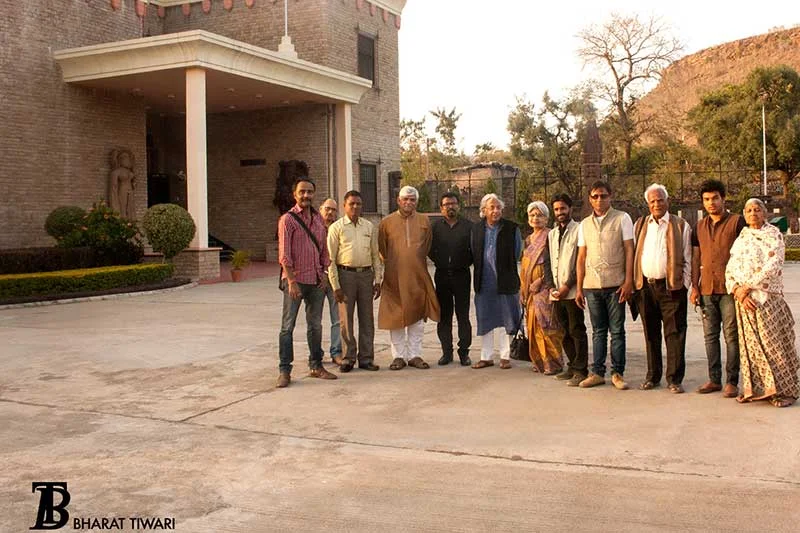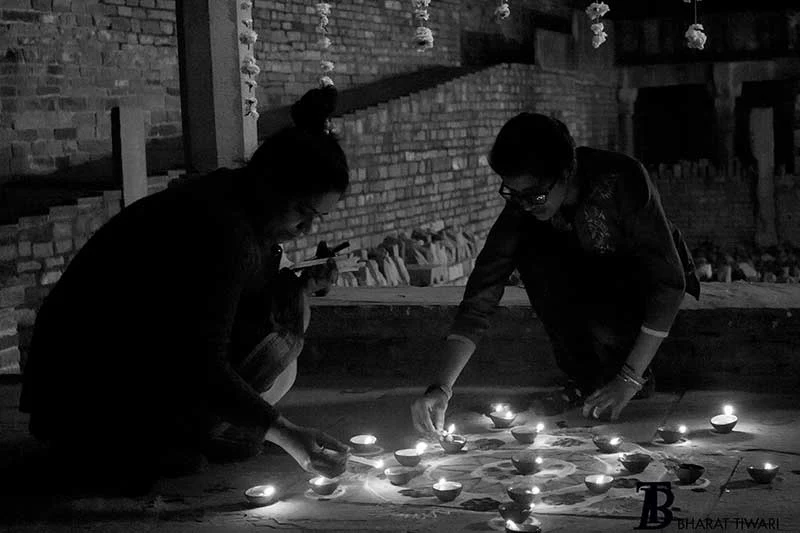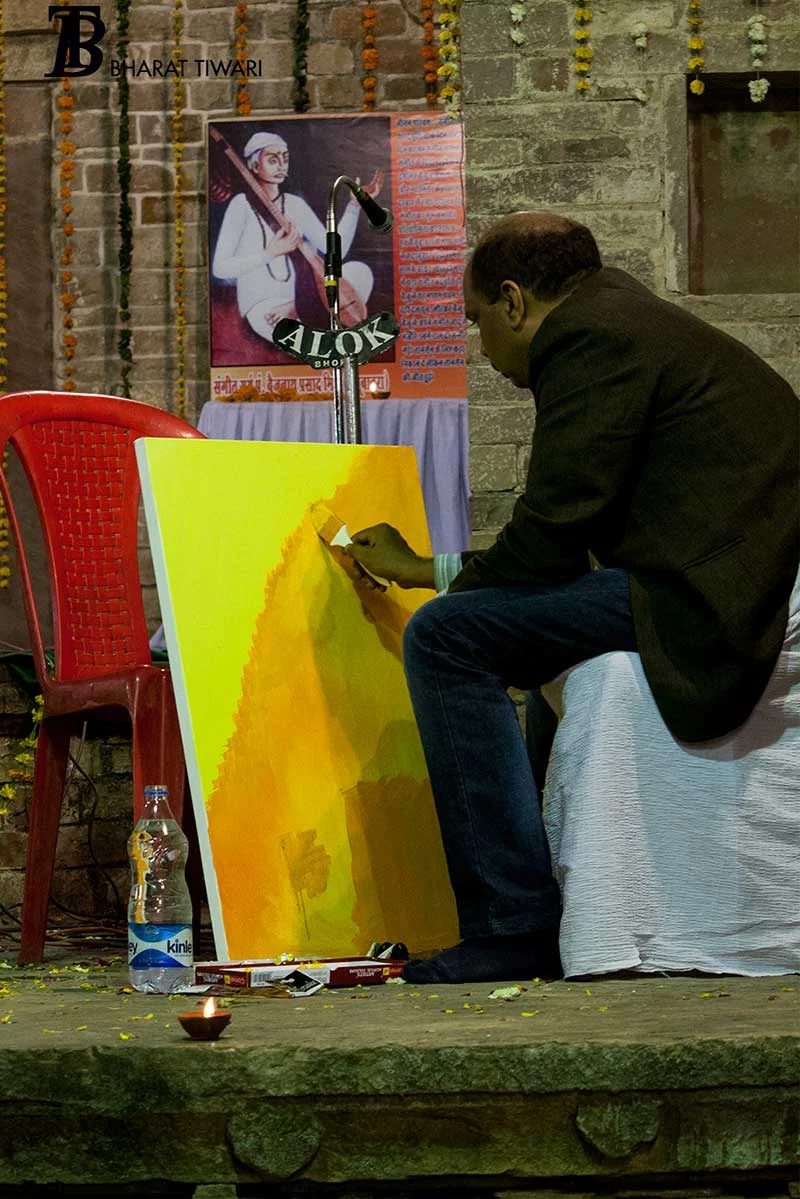We all know about Tansen, the famous court musician of Emperor Akbar, but one hardly hears about his Guru Bhai and contemporary musician Baiju Bawra, who chose to live a life of oblivion, singing for himself. Many people even believe and take Baiju Bawra to be a better musician than Miyan Tansen. Baiju Bawra spent the last few years of his life in Chanderi and breathed his last there on Basant Panchami day in 1610. His samadhi is situated in Chanderi, located on the border of Malwa and Bundelkhand.
 |
| Chanderi — A veranda outside the Raja Rani Mahal — Photo © Bharat Tiwari |
 |
| Chanderi — Choubisi Jain Temple — Photo © Bharat Tiwari |
 |
| Chanderi — Burj at Raja Rani Mahal — Photo © Bharat Tiwari |
The Achaleshwar Mahadev Mandir Foundation (SAMMF) took a welcome initiative to start an annual Dhrupad festival at Chanderi, as a tribute to this legendary musician. The Pratham Baiju Bawara Dhrupad Utsav was organised by the SAMMF in association with the Raza Foundation and the Nagar Palika Parishad, Chanderi in memory of Baiju Bawra on his Punya Tithi Basant Panchami, the 13th of February, at the Raja Rani ka Mahal in Chanderi. The SAMMF got full cooperation by the people and the local authorities because this was also an opportunity to bring Chanderi into the limelight as an art and culture destination in Central India.
 |
| Chanderi — a staircase, Raja Rani Mahal — Photo © Bharat Tiwari |
 |
| Chanderi — A silk loom at Raja Rani Mahal — Photo © Bharat Tiwari |
 |
| Kiran Tiwari — moderating session 'Virasat Ka Arth'— Photo © Bharat Tiwari |
 |
| Ashok Vajpeyi and Gundecha Brothers in conversation 'Virasat Ka Arth'— Photo © Bharat Tiwari |
 |
| 'Chanderi Museum'— L-R Bharat Tiwari, Shivkesh Mishra, Visitor, Gundecha, Manish Pushkale, Ashok Vajpeyi, Manjari Sinha, Chandra Prakash Tiwari, and 4 visitors — Photo © Bharat Tiwari |
The festival began in the morning with a dhrupad workshop for the school children and college students of Chanderi and nearby places, with renowned dhrupad artists and Padma Shri awardees Gundecha Brothers who talked about the significance and majesty of the oldest form of Indian classical music derived from Sama Veda; and let them experience the beauty of dhrupad music. Gundecha Brothers also acquainted them with Baiju Bawra, the devoted disciple of Swami Haridas, and explained why they should be proud of him!
 |
| Sunset at Kirti Durg | Chanderi fort | Qila Kothi — Photo © Bharat Tiwari |
 |
| Majari Sinha admiring the beauty of Chanderi from Chanderi fort — Photo © Bharat Tiwari |
 |
| Mansih Pushkale at Chanderi fort — Photo © Bharat Tiwari |
 |
| Samadhi of the great musician, Baiju Bawara (1542-1613) — Photo © Bharat Tiwari |
There was a lecture and interactive session in the afternoon, with music lovers of Chanderi on “Virasat Ka Arth”, the meaning and significance of legacy and inheritance. The speakers were Ashok Vajpeyi, Ramakant and Umakant Gundecha and this critic. The evening started with the floral tribute at the samadhi of Baiju Bawra. The first Baiju Bawra Smriti Samman was awarded to the Gundecha Brothers Ramakant and Umakant Gundecha this year; who gave a dhrupad recital in the aesthetically elevating ambience of the open air stage of the Raja Rani ka Mahal, the 16th century heritage building of the Bundela Kings; divinely decorated with flowers and earthen diyas.
 |
| Silhouette da Chanderi fort — Photo © Bharat Tiwari |
 |
| Kiran Tiwari (left) with her mother and sister— Photo © Bharat Tiwari |
 |
| Raja Rani ka Mahal, divinely decorated with earthen diyas — Photo © Bharat Tiwari |
 |
| Ashok Vajpeyi lighting the diya, inaugurating the Baiju Bawara festival— Photo © Bharat Tiwari |
 |
| The editor's painting, Deo Prakash Choudhary at work — Photo © Bharat Tiwari |
Gundecha brothers opened their dhrupad recital with the meditative and detailed Aalap in raga Bhimpalasi. Although this is an afternoon raga of Kafi That; their reposeful presentation made it come alive as if it were minted for this very special evening. The Samvaad (harmony) between the two vocalist brothers is also their unique signature, where while one elaborates around Gandhaar or Pancham, the other works on or just holds the Samavaadi Swara.
 |
| Ramakant and Umakant Gundecha sing Jheeni jheeni beeni chadariya, with Roman Das on pakhawaj. — Photo © Bharat Tiwari |
 |
| Mansih Pushkale submerged, listening Dhrupad — Photo © Bharat Tiwari |
 |
| Ashok Vajpeyi and others get high on Dhrupad by Gundecha Brothers — Photo © Bharat Tiwari |
 |
| Portrait of Chanderi fort from Raja Rani mahal — Photo © Bharat Tiwari |
 |
| Chandra Prakash Tiwari, Secretary, Sri Achleshwar Mahadev Mandir Foundation — Photo © Bharat Tiwari |
 |
| Book release L-R Umakant Gundecha, Ramakant Gundecha, Ashok Vajpeyi, Deo Prakash Choudhary, Manish Pushlake, Shivkesh Mishra and Chandra Prakash Tiwari— Photo © Bharat Tiwari |
The hour-long Aalap was followed with the dhrupad “Kunjan mein rachyo raas…” set to Chautala. They also sang the poetry of Nirala and Kabeer. Since Chanderi is also a place of weavers they sang the popular Kabeer Bhajan “Jheeni jheeni beeni chadariya…” set to Drut Sooltala. Roman Das provided adequate support on pakhawaj.
The event was simultaneously captured on canvas by two artists on either side of the stage. A book “Sunata Hai Guru Gyaani’ written by Umakant and Ramakant Gundecha was also released on this occasion.











































